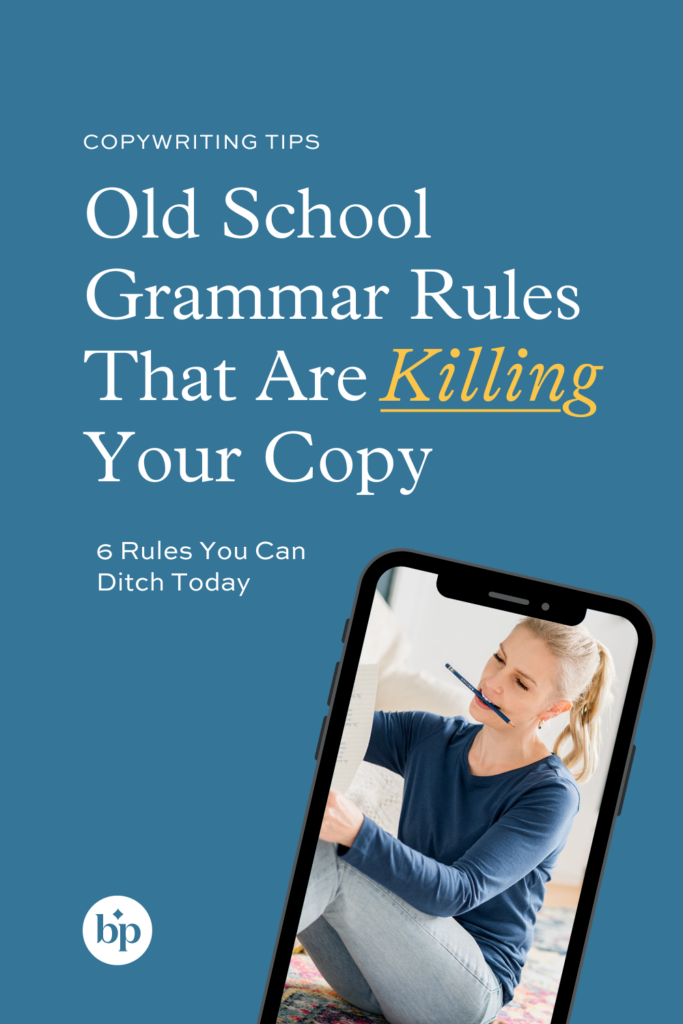The most fascinating course I took in college was Linguistics 101. Linguistics is the study of language — dialects, colloquialisms, historical vowel shifts, and everything a nerdy little bookworm like me adores. It was during this course that I learned the original way to say “am not” in the 1700s was “ain’t”. It wasn’t until Charles Dickens started using the word to create a “lower-class” dialect that “ain’t” became out of fashion. This was mind-blowing as someone who spent the better part of fifth grade staring at a contradictory poster on the wall stating “Ain’t, ain’t a word. Use proper grammar.”
Writing is a crucial skill for businesses and marketers. The words you choose to convey your messaging can make or break your success in capturing the attention and engagement of your target audience. However, there’s a long-standing debate about the role of traditional grammar rules in modern copywriting. Are these rules still relevant, or do they hinder your ability to connect with your readers? Do you really need to know the rules before you can break them? When is keeping your writing more formal and less conversational the better choice?
I have opinions on the matter.
In this post, we’ll explore some old-school grammar rules that may hurt your writing and discuss how to strike a balance between adhering to them and crafting compelling copy that resonates with your audience.
Does “proper” grammar matter anymore?
The English language is (and always has been) in a constant state of evolution but online media has propelled this evolution. The rise of social media and online content exposes us to hundreds of thousands of people all over the world, with varying grammar and speech patterns, both written and spoken. If you’re wondering where the slang “cheugy”, “dank”, and “It’s giving…” came from, you can thank TikTok, Reddit, and your favorite influencers.
When you write, communicating clearly is your goal. And, yes, having a system of rules everyone follows helps us all understand each other. However, most of these rules exist because we tried to make English conform to Latin grammar rules (#notthesame) or because someone influential held a personal preference and society followed suit (a la Charles Dickens.)
But overly prescriptive rules don’t always translate well to advertising and marketing copy and trying to adhere to them can cause you to twist your language in unnatural ways. Here are a few reasons to loosen your collar and incorporate a more conversational tone into your copy.
Benefits of using informal grammar and slang in your marketing messaging
Relevancy
Younger generations, particularly Millennials and Gen Z, often prefer brands that adopt a conversational tone. They value authenticity, transparency, and personal connections with brands. By using more informal language, you will resonate better with these demographics, ultimately influencing their buying decisions.
Emotional Connection
Speaking to your customers like their friend or neighbor can foster a sense of trust, loyalty, and empathy, making customers more likely to choose and recommend your business over your competitors.
Higher Ratings/Reviews
Conversational interactions often receive positive feedback and higher customer satisfaction ratings. From your first touch point (like your confirmation messaging and welcome emails) to your last (order confirmations, and “We miss you” promos”), customers appreciate businesses using approachable language which creates a more pleasant and memorable experience for everyone.
When should you stick to traditional grammar rules?
If you’re writing for a publication or organization with an official brand style guide, you should obviously adhere to their rules. If you’re writing for yourself, you make the rules within your own business, but there are certain situations where you should double-check your grammar and tone before communicating with someone else.
Pitching Media & Brand Partnerships
You don’t have to lose your brand flavor when pitching yourself for outside opportunities, but you should research who you’re reaching out to and strive to match their vibe and level of formality. Correcting “gonna” to “going to” isn’t going to kill you.
Discussing Sensitive Topics
Brands get this wrong all the time and it’s usually because they are desperately trying to insert themselves into a cultural conversation in a self-serving way. Avoid a “read the room” faux pas, and assess the context of the situation before communicating. Nothing feels more disrespectful than a lack of empathy. Avoid potential misunderstandings or offenses by taking a moment to assess which is the appropriate way to respond or contribute to a conversation respectfully.
Any situation where formality is expected (duh)
Do your homework and research your audience. Maintaining a formal tone is crucial if you are writing for a professional, academic, or technical outlet. And I’d be willing to bet that challenging the status quo is not appreciated.
If you’ve got the green light on the above but are still carrying 11th-grade English exam stress, I hereby give you permission to:
End your sentence with a preposition
Unless your brand voice is English-Lord-who-fancies-a-game-of-croquet you can say:
- “A white-glove experience that makes your clients feel taken care of”
instead of
- “A white-glove experience that makes your clients feel like you’ve taken the utmost care of their well-being.” #wordy #stuffy
When you run into a dangling preposition, see if you can rephrase your sentence. For example, instead of saying:
- “Become the kind of leader your team looks up to”
try
- “Become a leader your team respects/admires/that empowers your team.”
It’s perfectly acceptable to end a sentence with a preposition if the alternative would create confusion or sound ridiculous.
Start a sentence with And, But, Because
Starting a sentence with a conjunction sounds like how we naturally speak. But it also helps to pace your copy. It gives the reader a moment to pause and can help emphasize a point or highlight a juxtaposition. You can always attempt to rewrite your sentence but if reordering the words loses the conversational ease you’re going for, then lead with and, but, because, however, yet, so at will. Because you’ve got more important things to be concerned with. (And not, because you’ve got more important things with which to concern yourself. 😉 )
Use contractions
Unless you like sounding stilted, contractions are fine. But I’ll go one further. It used to be the advice that you should either only use contractions or not use them throughout your entire piece of content. That’s not how we speak and our brains actually like variance, which often helps us create melodic or rhythmic text. It’s why poetry and rap lyrics can feel hypnotic. If you attempt to follow an arbitrary rule like this, you’re writing for the rule and not your audience.
Write fragmented sentences
I don’t know about you but this was my #1 suggested correction back when Word still used Clippy the paper clip to mock my school papers. A fragmented sentence is an incomplete sentence (missing a noun or verb) pretending to be a complete one. In marketing and advertising, they are used to grab attention and create impact.
Example:
“Got milk?” (Tagline)
“Unleash your potential. Be unstoppable.” (Headline)
“Remember flipping through your grandmother’s photo album as a kid? The leather album. The one you used to rub your fingers against until the gold lettering disappeared.” (Body copy “painting the picture” on a photographer’s homepage.)
Sentence fragments are frowned upon in formal writing, but they can be used strategically in copywriting to grab attention and create impact. Short, punchy phrases or incomplete sentences can help convey your message more effectively and add emphasis where needed. Also, no one except a copyeditor will read your copy and say, “This sentence is fragmented.” If your reader cannot understand your copy or struggles with your sentence construction, the fragment is probably not the biggest issue.
Choose Who (not Whom)
The great “Who” vs. “Whom” debate is dying out because the majority of people don’t know how to use it or why they should use it. Grammar rules are intended to clarify language to avoid confusion but if I have to Google the correct usage every time, I’m going to choose to rewrite my sentence to avoid Who/Whom or throw caution to the wind, choose “Who”, and move on with my life.
Here are some examples where we use “Who” when it should be Whom to support its death further:
- Whom You Gonna Call? Ghostbusters!
- See whom you match with!
- Twitter recommends whom to follow
- With whom did you meet?
If you find yourself wrestling over “who” vs. “whom” in a sentence, your best bet is to rephrase the sentence to avoid the issue altogether or save yourself the mental hurdle and just choose “Who”. Not convinced? Read: “For Whom The Bell Tolls” in The Atlantic.
Ditch 5-Sentence Paragraphs
Unless you are writing a third-grade essay there is no reason to follow this rule. The reason the 5-sentence construction exists is to teach you the basic tenets of forming a convincing argument. (Introduction – State Your Claim – Give Your Evidence – Explain Your Evidence – Summarize 1-4).
The shift to shorter paragraphs online is the result of our desire for better readability on our screens. A 5-sentence paragraph can create a wall of text on a mobile screen and UX analysis shows readers will quickly exit a text-heavy page if there’s nothing there to anchor or stimulate them. However, this doesn’t mean you need to switch to 1-liner content. Breaking your paragraphs up into smaller chunks is one of my favorite 6 Copywriting Tricks That Have Nothing To Do With Words. Read the post to explore the other ways you can format your copy so it’s easy to read and keeps your readers scrolling.
The TL;DR
Despite the constant changes to the way we communicate, you’ve probably come across “The Grammar Police”, judging your every comment and caption. But the truth is, most traditional grammar rules don’t work with marketing copy where the goal is to connect, feel relevant, and reflect the way your audience talks and thinks. With every new generation comes slang and a different (informal) way of communicating. Blogs are now being written in one-sentence-per-line format (not this one, obviously) and err on the side of Search Engine Optimization instead of storytelling.
The presence of online media is speeding up the language evolution, so much so that it’s safe to say you can drop these old-school grammar rules that are killing your copy:
- Ending your sentence with a preposition
- Starting a sentence with And, But, Because (conjunctions)
- Using contractions
- Writing fragmented sentences
- Using Whom vs. Who
- Writing 5-sentence paragraphs
And since you asked 😉 , no, you don’t need to understand the rules before you break them if you’re confident your writing is clearly understood by your audience (get someone else to read your work) and reflects your brand’s preferred communication style.
If you find my articles & free resources helpful…
THE BP RESOURCE LIBRARY STARTED AS A WAY TO OFFER BRAND STRATEGY AND COPYWRITING EDUCATION TO CREATIVES AND ENTREPRENEURS WITH CHAMPAGNE TASTES BUT A PELLEGRINO BUDGET.
If I’m helping you make more sense of this whole “writing for your biz” thing, please consider expressing your appreciation for the research, writing, and design that goes into each and every post and library freebie.
Leave a tip of appreciation.
PIN TO SAVE FOR LATER

